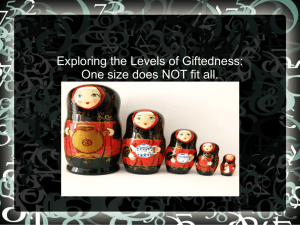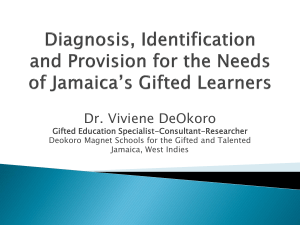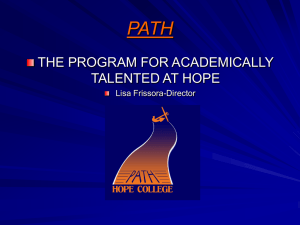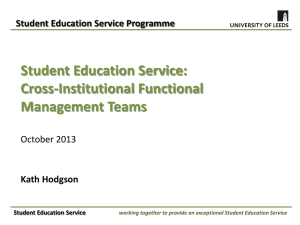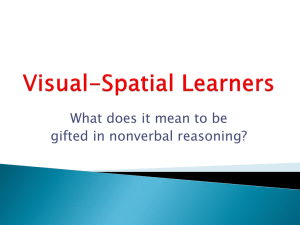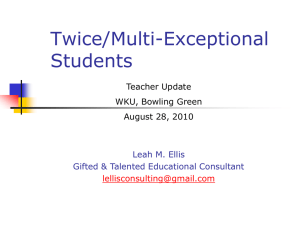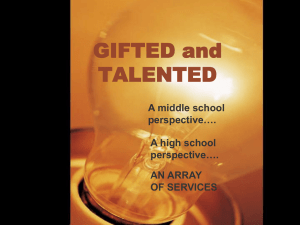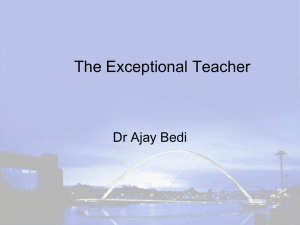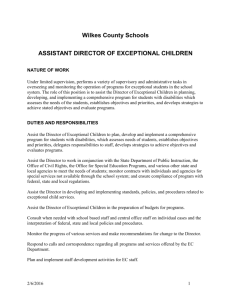Overview of Twice Exceptional Learners
advertisement
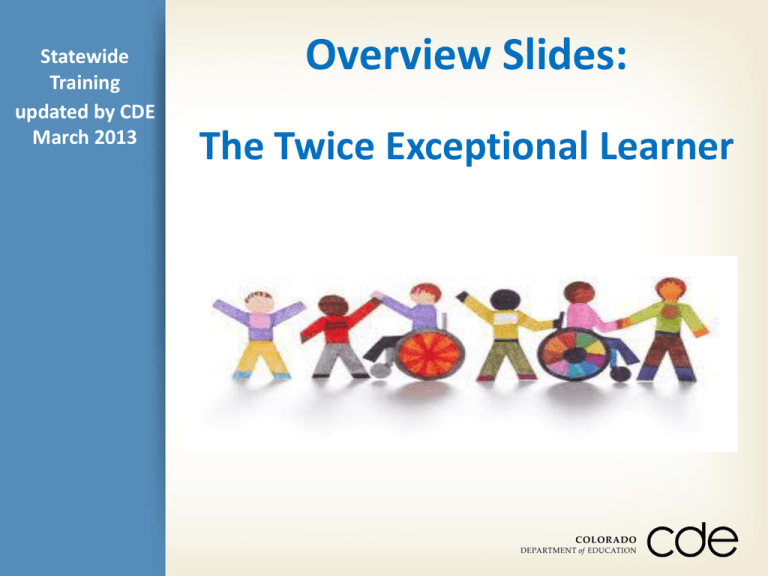
Statewide Training updated by CDE March 2013 Overview Slides: The Twice Exceptional Learner Together We Can Vision All students in Colorado will become educated and productive citizens capable of succeeding in a globally competitive workforce. Mission The mission of CDE is to shape, support, and safeguard a statewide education system that prepares all students for success in a globally competitive world. 2 Twice Exceptional Learner Twice Exceptional Learner Jacquelin Medina medina _j@cde.state.co.us (303) 866-6652 Wendy Leader leader_w@cde.state.co.us (303) 866-6414 3 Twice Exceptional Learner A gifted student with a disability is Identified in one or more areas of giftedness, and Identified with a disability according to federal disability eligibility criteria, or served through a 504 Plan. 4 Categories of Giftedness Gifted students are defined with exceptional potential in one or more of the following categories: Specific academics, such as Reading, Writing, or Mathematics General intellectual ability Creativity Leadership Visual, musical, or performing arts 5 12.02 (1) (c) Identification procedure. The program plan shall describe the assessment process used by the AU for identifying students who meet the definition specified in section 12.01(12) and for identifying the educational needs of gifted students. The assessment process shall recognize a student’s exceptional abilities or potential, interests, and needs in order to guide student instruction and individualized programming. The assessment process shall include, but need not be limited to: 12.02 (1) (c) (i) A method(s) to ensure equal and equitable access for all students. The program plan shall describe the efforts the AU will make to identify gifted students from all populations, including preschool (if applicable) through twelfth grade students, minority students, economically diverse students, culturally diverse students, students with limited English proficiency and children with disabilities; 6 12.02 (1) (c) (ii) Referral and screening procedures; 12.02 (1) (c) (iii) Multiple sources of data in a body of evidence (i.e., qualitative and quantitative); 12.02 (1) (c) (iv) Criteria for determining exceptional ability or potential; 12.02 (1) (c) (v) A review team procedure; and 12.02 (1) (c) (vi) A communication procedure by which parents are made aware of the assessment process for their student, gifted determination, and development and review of the student’s ALP [Advanced Learning Plan]. 7 Intellectual Ability 95th percentile and above on norm-referenced, standardized cognitive tests or subtests Examples: WISC-IV Cognitive Abilities Test (CogAT) Nonverbal abilities tests (e.g., Naglieri ) Behaviors/ Characteristics Observation of behaviors or traits demonstrating outstanding or exceptional factors Body of Evidence Examples: Kingore Observation Inventory Gifted Evaluation Scale Demonstrated Performance Distinguished Level of Performance Examples: Juried performances Advanced portfolio 8 Achievement 95th percentile and above on norm-referenced or criterion-referenced standardized tests Advanced on a standardsbased test Examples: Scantron NWEA/MAP TCAP Acuity Paradoxical Characteristics Strengths Challenges Superior vocabulary Written expression Advanced ideas Lack of organization High level questioning Argumentative Problem solving ability Difficulty with social interactions Easily frustrated Intense interest in topic(s) 9 What if …? A student exhibits very high performance in one area and low performance in another. A student exhibits extreme knowledge base and vocabulary, but output is minimal and of poor quality. A student demonstrates keen understanding but behavior and attention or sensory motor skills are poor. 10 Twice Exceptional Learners Discovery Pathways to Recognizing Clues about Twice-Exceptionality Observation by parent, teacher, or specialist Student performance data Information collected through Response to Intervention IEP evaluation process Gifted evaluation process 11 Collaboration Twice Exceptional Learners Discovery When paradoxical characteristics are recognized through any one pathway, a collaborative response should be initiated among Gifted education Special education General education Families 12 Next Steps Initiate consultation about the individual student’s data collected through observations and assessment. Involve gifted, general and special education staff and family in collaborative problem solving efforts. Collect additional data and implement interventions or strength-based programming as needed. Initiate eligibility determination processes as appropriate for the individual student according to gifted and special education guidelines and criteria. 13 Thank You! 14

